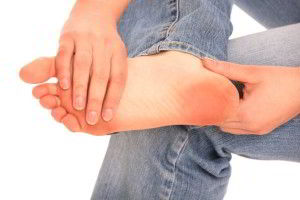Bursitis of the foot is considered an extremely unpleasant disease that develops against the background of inflammatory processes in tendon and joint bags of the foot.
Its characteristic feature is the spread of pathology among women because of wearing not too comfortable shoes.
The specialists of the disease are divided into several subspecies having their own individual symptoms and treatment therapy.
The following joint joints on the foot are subject to inflammatory processes in most cases:
- Achilles tendon;
- bursitis of the thumb or little finger;
- subcutaneous calcaneal bursa (plantar aponeurosis).
In order to better understand the mechanism of development of pathology, it is necessary to understand what a synovial bag (bursa) is. It is a connective tissue capsule, the purpose of which is to protect the joint. The presence of synovial fluid in the bag reduces friction of the joint, thus protecting it from abrasion.
With inflammation, the bursa begins to intensively secrete synovial fluid, which is the reason for its increase. In this case, the patient has severe pain and swelling. The human foot consists of 7 articular joints and 10 synovial bags.

Causes of the disease
Bursitis of the foot is provoked by various factors that differ in the nature of the origin:
- infection infection. A disease that occurs for this reason develops against the background of injury, abrasion, or bruising. The infection penetrates the wound and enters the bursa. The causative agents of bursitis, causing purulent inflammation, are staphylococci, streptococci, etc. Also, a similar pathological condition can occur after osteomyelitis, furunculosis or erysipelas;
- load on the foot. There are frequent cases when the disease is diagnosed in professional athletes. Also, bursitis of the foot develops with prolonged wearing of uncomfortable high-heeled shoes. The unnatural position of the foot causes deformation of the synovial bag and becomes the cause of the subcutaneous calcaneal bursa;
- endocrine disorders. Against the background of hormonal disorders, the patient is most often overweight, which leads to an additional load on the joint. Also, the endocrine system that works with disorders can cause inflammation in the bursa of the joints of the foot.
The main signs of inflammation of the Achilles tendon
Achilles tendon is a continuation of the triceps muscle of the leg, connected to the calcaneus. Bursitis of the foot of this type most often occurs against a background of intense exertion, as well as rheumatoid arthritis. The danger of the disease is that untimely or improper treatment can cause rupture of the Achilles tendon. Such an injury does not allow the patient to move around and requires long-term therapy.
Symptoms of inflammation of the Achilles tendon are as follows:
- pain comes from the heel zone or is felt throughout the tendon;
- the zone turns red and swells;
- when trying to lean on socks, the intensity of pain increases sharply;
- limited foot movements in the ankle region.
Symptoms of bursitis are also manifested by a characteristic crunch that is heard well by the phonendoscope, and in later stages it is clearly audible without it.
Treatment of inflammation of the Achilles tendon of the initial form involves the selection of more comfortable shoes on a low sole, the introduction of anesthetics and glucocorticosteroids. As for the acute form, the treatment is carried out in conditions of complete immobilization of the foot. For this, a fixing bandage is applied. Also, therapy involves the application of compresses and ointments.
Bursitis of the thumb or little finger
Bursitis of the foot of this type is most often caused by flat feet, uncomfortable shoes with high heels or having a narrow toe. These factors contribute to an unnatural bend of the foot and trauma to the joint, which leads to a change in the position of the thumb or little finger.
Symptoms inherent in this type of disease:
- slight swelling in the affected area;
- sharp pain when walking;
- at the initial stage, a small solid compaction forms, and a little later bone marrow appears clearly;
- limitation of mobility of the affected fingers;
- at later stages, the curvature and deformation of the thumb or little finger are clearly visible.
The symptoms accompanying bursitis are very much like gout. Therefore, upon examination, the specialist asks the patient to walk. When walking, the deviation of the fingers from the natural axis is very clearly visible.
The disease at the initial stage in a patient does not cause particular discomfort and is only an aesthetic problem. Therefore, treatment involves the selection of more comfortable shoes or the use of orthopedic. Also, the specialist can be assigned to wear special devices that help align the position of the fingers and reduce the load on the affected area.
If such therapy did not bring relief to the patient, then conservative treatment is prescribed, including taking anti-inflammatory drugs and injections of glucocorticosteroids into the joint cavity. Also, physiotherapy procedures have a good therapeutic effect.
Surgical treatment is used in the later stages when shoes, orthopedic appliances and injections are not able to improve the patient’s foot condition. Surgery involves the removal of the formed growth, partial removal of the synovial bag and balancing the muscle tissue located around the joint. Also, the patient may undergo a small reconstruction of the bone, which will prevent a new deformation of the joint.
Subcutaneous calcaneal bursa
Frequent irritation of the heel zone, to which tendons and ligaments are attached, causes inflammation (plantar aponeurosis) and acute pain. Over time, the inflamed ligament is impregnated with calcium salts and, during diagnosis, a bone growth (osteophyte) can be seen on the x-ray.
The symptoms that accompany this type of bursitis are manifested in the form of characteristic acute pains and the formation of a coracoid growth under the heel. The main causes of the disease are flat feet and heel injuries. Pain symptoms of the subcutaneous calcaneal bursa are very strongly felt in the morning, and in the afternoon they tend to decrease.
Toward night, they return again and cause discomfort. A humid climate and cold weather can provoke a deterioration in the patient’s foot condition. The presence of a pathological process on two limbs at once causes the patient to have a characteristic “ski gait” and forces him to use crutches or a cane.
It should be borne in mind that pain discomfort is caused not by the presence of a bone growth on the heel, but by inflammation of the tendon. Therefore, treatment should primarily be aimed at eliminating the inflammatory process. For this, the patient is prescribed antibacterial drugs, alcohol-cocaine blockades and shock wave therapy. At later stages, treatment may include surgical removal of the growth and washing of the synovial bag with antiseptics and antibiotics.
Despite its diversity, bursitis is successfully treated regardless of stage. And the exclusion of tight and uncomfortable shoes, traumatic factors and excessive loads on the foot will significantly increase the chances of success.



